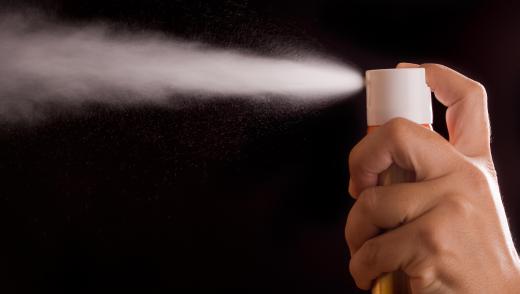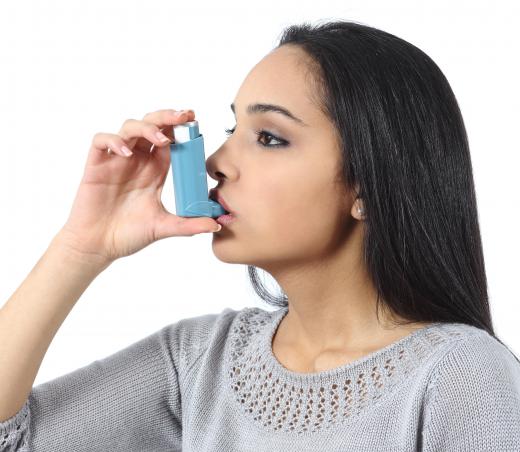What is Ambient Air?
Ambient air is basically the natural state of air in the outdoor environment, and is what humans and animals breathe. Plants and other organisms need it for survival, too. The exact composition of this sort of air can vary from place to place depending on fixed things like elevation, as well as more flexible things like pollution and smog. Its content and quality are directly affected by the day-to-day activities of humans. In turn, ambient air quality has a direct effect on both public health and the welfare of the Earth's ecosystems.
The Atmosphere Generally

The air that makes up the typical outside environment is a mixture of gases, but it’s usually about 78% nitrogen and about 21% oxygen. The remaining 1% is a mixture of carbon dioxide, methane, hydrogen, argon, and helium. It has no smell, color, or taste, and most people don’t spend much time thinking about what exactly it is they’re breathing on a day-to-day basis. Ideally, and perhaps originally, the air composition was more or less the same everywhere on the planet. Oxygen levels tend to be more plentiful near sea level, so some changes are usually inevitable at high elevations, but in general ambient air should be about the same everywhere. It isn’t, but this is usually more the fault of humans and human-driven pollution than any sort of natural phenomenon.
Problems With Pollution

Human activities, such as manufacturing and the burning of fossil fuels, cause changes in the chemical composition of the air through the release of chemical and industrial pollutants into the atmosphere. Air pollutants may include gases or particulate matter, which are small particles of dust, smoke, ash, pollen, and other substances. Many air pollutants have been found to be harmful to both the environment and human health. Pollutants known to have adverse health effects are called criteria pollutants. Criteria pollutants include ozone, lead, carbon monoxide, nitrogen dioxide, sulfur dioxide, and particulate matter.

Certain populations are most likely to be adversely affected by criteria pollutants. These include infants, children, the elderly, and people with cardiopulmonary conditions. In children, criteria pollutants have been shown to increase the risk of respiratory tract infections and worsen the severity of asthma attacks. In adults, exposure to particulate matter is associated with an increased risk of hospitalization and death due to cardiovascular disease. People who live in places with extreme pollution are often advised to wear protective masks on their faces during particularly bad days or, better yet, simply stay home.
Environmental Ramifications of Change

Changes to air composition can cause problems for more than just people. Pollution and atmospheric shifts are one of the contributing factors many scholars point to when explaining the global warming phenomenon, for instance, and these shifts are often thought to undermine the ideal workings of the earth’s greenhouse effect. When the atmosphere gets heavy with smog or other pollutants, it can trap solar radiation in the lower atmosphere, which artificially boosts temperatures and can lead to any number of problems with plant and animal life, as well as things like tidal patterns, ocean depths and temperatures, and ice cap densities.

Air pollution also contributes to depletion of the ozone layer, the region of the atmosphere that protects the Earth from harmful types of ultraviolet radiation. Acid rain, which is basically rainfall that contains toxic chemicals along with ordinary water, is also a possible side effect of long-term changes in air composition.
Filtration and Other Remedial Measures

There are a couple of things people can do to help prevent further damage to ambient air standards around the world. First, and most importantly, they can work to lessen emissions from cars and manufacturing facilities. Legislation and the force of national laws is one way to help encourage these sorts of changes. The United States, for instance, enacted the Clean Air Act in 1970 to set limits on emissions and penalties for violators. The act also set national standards for certain pollutants in order to safeguard the public health, ensure the welfare of animals and crops, and protect the health of the Earth’s ecosystems. Many other countries have similar regulations in place.
Individuals can sometimes improve the immediate quality of their air by using things like home-based filtration systems. There are many different filter types available, but many work to actually clean and purify air from the environment and then pump it, scrubbed free of chemicals or other harmful substances, into an enclosed space. Small filters work best in homes and individual offices, though larger models can sometimes be attached to air conditioning units to process the internal environments for much larger buildings, too.
AS FEATURED ON:
AS FEATURED ON:
















Discussion Comments
Thank you for this article. I am going to be doing a unit on ambient air, gas, and pollution for my class next semester, and this really gave me a good jumping off point to start my research.
The only thing I would like to learn a little bit more about is how you can monitor the temperature of ambient air. I thought that it might be a fun experiment for the kids in my class to monitor the temperature with one of those ambient air temperature gauges, and see how it differs from other temperature gauges.
Could you give me a little information about how to do this?
My daughter has severe allergies, so we're really familiar with the whole process of ambient air monitoring.
When she was younger, before we knew what was going on, my daughter used to always have a cold. It was one of those things were at first you think it's just a long-term virus or something, but after a year of her continually carrying tissues around and having chronic sinus infections, we finally found a doctor who told us that she was actually allergic to the air where we lived.
At the time we were living in a very urban area with a lot of pollution and very little monitoring. All the pollution was continually irritating her respiratory system, sending it into overdrive trying to clean itself.
Well, we actually ended up moving, and that, combined with medication, has really helped a lot. And the funny thing is, I actually feel a lot healthier too just living in a cleaner area. It's really amazing just how much dirty ambient air can affect us, and how easy it is to not notice!
Excellent article. So many people just never think about how the ambient air effects them on a daily basis, but it really does have such a powerful influence on your life.
Although some news stations have started offering ambient air monitoring as part of their weather broadcasts, I think that most people still really don't understand why it's important.
Well, let me clear it up a little bit for you. Polluted air causes a whole host of diseases and conditions, from your basic cold and cough type of thing to asthma, lung cancer, and even cardiovascular disease.
This is because air (via breathing) is such an important part of how the body functions, and when you continually breathe in dirty air, it's just like putting dirty gas in your car's tank. Although it might keep running for a while, eventually you're going to see some damage.
Unfortunately, many people simply don't realize this until it's too late because we adjust to the different levels of pollution and don't even realize its there until something goes seriously wrong.
However, there are a lot of things you can do to prevent this. Keep up with the ambient air sampling on the weather channel (if you have it) and avoid heavy pollution days. Also, consider investing in an ambient air cleaner -- you'll notice a difference immediately, and you will just feel better.
Post your comments